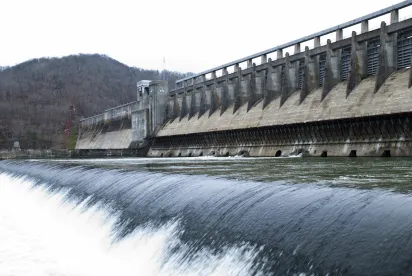U.S. District Court Rejects Appeal of Corps 404 Permit and Biological Opinion as Collateral Attack on FERC License Amendment Order
In Save the Colorado v. Semonite, U.S. District Judge Christine Arguello ruled that the U.S. District Court for the District of Colorado did not have jurisdiction to hear a challenge by environmental groups to a Clean Water Act (CWA) section 404 permit issued by the U.S. Army Corps of Engineers (Corps), or an associated biological opinion under the Endangered Species Act (ESA) issued by the U.S. Fish and Wildlife Service (USFWS), for the City and County of Denver’s proposed dam raise and reservoir expansion. In a March 31 order, the district court dismissed the case, finding that the exclusive forum for challenging the dam raise was in the U.S. court of appeals because both agency approvals were “inextricably intertwined” with a license amendment granted by the Federal Energy Regulatory Commission (FERC) under the Federal Power Act (FPA). The case is notable because, although there is considerable precedent prohibiting collateral challenges to federal agency actions that establish conditions FERC must include in its licensing decision, such as biological opinions, the court expanded that doctrine to include an agency permit, here the Corps’ 404 permit, issued under entirely independent regulatory authority.
Under the FPA, federal courts of appeals have “exclusive” jurisdiction over challenges to FERC actions, including licensing decisions. This exclusive jurisdiction, the judge wrote, applies not only to direct challenges to the FERC order itself, but “all issues inhering in the controversy” related to it. In cases where a party does not directly challenge the FERC order, but that of another agency order that is inextricably linked to the FERC order, the FPA’s exclusive-jurisdiction provision applies, vesting sole review authority in federal appeals courts. According to the district court’s reasoning, the CWA 404 permit, USFWS biological opinion, and FERC license amendment were all “necessary ingredient[s]” in allowing the licensee to proceed with the dam expansion.
The decision has important implications for litigants in FERC license proceedings because the FPA has statute of limitations and standing requirements that are much more stringent than those under the Administrative Procedures Act. A stakeholder seeking to challenge a FERC order in the U.S. court of appeals must have been an intervenor in the FERC proceeding, must have filed a timely request for rehearing with FERC within 30 days of the FERC order, and must file a timely petition for review with the court of appeals within 60 days of FERC’s denial of rehearing. The ruling also raises a question of the proper forum for challenging other regulatory approvals involved in FERC license proceedings, such as state water quality certifications under section 401 of the CWA, and approvals of federal land management agencies under the Federal Land Management and Policies Act.
Federal Court Invalidates Agency Approval Based on Improper Segmenting of Effects Analysis under the ESA
A federal district court has quashed the federal government’s approval of the early stages of a major copper and silver mine in Montana’s Cabinet Mountains Wilderness based on failure to consider the effects of future phases of mine development. In Ksanka Kupaqa Xaʾⱡȼin v. U.S. Fish & Wildlife Service, the Missoula Division of the U.S. District Court for the District of Montana ruled on April 14, 2021, that the USFWS erred when it approved an exploratory phase of the Rock Creek Mine project, ignoring the impact of the proposed mine on federally protected species of bear and trout of future activities that were reasonably certain to occur. The mining company was required to obtain a permit from the U.S. Forest Service, which was obligated to consult with the USFWS under section 7 of the ESA.
The area of the proposed mine is home to bull trout—a native fish species protected by the ESA—and one of the last few grizzly bear populations in the continental United States. Members of the Ksanka band of the Ktunaxa Nation, along with conservation groups, filed suit in state and federal courts, challenging the legality of the federal permits for the mine. Although the mining company argued that future development would require a separate ESA consultation, the court held that the agencies’ failure to consider the effects of future development, including the removal of 10,000 tons of ore per day with a production life of 26 to 30 years, in the approval of the initial stage was an improper segmentation of the required analysis under ESA section 7.
California District Court Finds Species Conservation Is Not One of Twitchell Dam’s “Other Purposes”
A federal judge’s decision rebuffed environmental groups’ effort to increase water flow from California’s Twitchell Dam, stating that wildlife conservation was not among the dam’s authorized purposes and that the U.S. Bureau of Reclamation (Bureau) had no authority to modify the water releases for conservation purposes.
U.S. District Judge André Birotte Jr. sided with defendants in San Luis Obispo Coastkeeper v. Santa Maria Valley Water Conservation District, rejecting plaintiffs’ claim that by failing to release enough water to benefit protected steelhead trout, the Bureau and local water district were in violation of the ESA.
At the heart of the dispute was whether conservation—in this case, protecting a species of trout—was among the dam’s purposes when it was created, and whether the Bureau was authorized by law to increase water flow. Under section 9 of the ESA, it is illegal take or harm an endangered species. This includes any “significant habitat modification or degradation” that kills or injures a protected species, such as by disrupting feeding or spawning patterns. Environmental groups argued that current levels of water released from the dam are too low to establish a pathway for steelhead trout to migrate and spawn, resulting in unlawful take of protected species prohibited by the ESA. They sought an order to modify the dam’s operations to increase water flow.
The district court disagreed, stating that conservation was not among the dam’s purposes at its creation, and that the Bureau had no discretion to modify Twitchell Dam releases in the manner environmentalist groups seek. The Court pointed out that Public Law 774, which authorized the dam, aimed to conserve water “by limiting releases from the dam.” While reports considered water flow and fish loss from the dam, increasing water flow to benefit protected species was not among the recommendations when the dam was under consideration, the court wrote. Increasing water flow would result in waste, and “conflicts with the express water conservation purpose of Twitchell dam.”
The court added that because the agency “has no ability to prevent a certain effect” due to this limited statutory authority, failure to increase releases from Twitchell Dam is not the legally relevant cause of the alleged harm to ESA-protected species. The case has implications for other limited purpose federal dams where environmental groups have claimed that the existence of the dam causes a take of listed species by blocking fish migration or altering habitat downstream.
Clean Energy for America Act Proposes to Create a Technology-Neutral Tax Credit
Senate Finance Committee Chairman Ron Wyden (D-OR), along with 27 cosponsors, introduced the Clean Energy for America Act (S. 1298) which would modify energy tax incentives for electric generation, transportation fuels, and building energy efficiency. The legislation, which is expected to be part of the larger infrastructure and energy legislation that the Senate will consider this year, would create a technology-neutral tax credit for the production of clean electricity from facilities that have zero or net negative carbon dioxide (CO2) emissions. Electric generators would be able to select either a production tax credit of up to 1.5 cents per kilowatt hour of electricity produced and sold in the 10 year period after a qualifying facility is placed in service or an investment tax credit of up to 30 percent of the investment in the year the facility is placed in service.
The bill allows investments in critical grid improvements, like stand-alone energy storage and high-capacity transmission lines, to qualify for the investment tax credit, as well as permitting power projects and grid improvement projects to claim the tax credits as direct payments. The legislation phases out the tax credit when the Department of Energy and the Environmental Protection Agency certify that the electric power sector emits 75 percent less CO2 than 2021 levels. Once the phase out begins, facilities would be able to claim the whole tax credit in the first year, 75 percent for the second year, 50 percent in the third year, and then down to zero.
Drought Relief Working Group to Address Western Water Crisis
On April 21, 2021, during the Third National Climate Task Force Meeting, the White House announced the formation of an interagency working group to tackle the severe drought affecting the western United States. The working group, which will be helmed by the Departments of Agriculture and the Interior, will explore opportunities to improve the Nation’s resilience to severe climate impacts such as droughts and prioritize long term measures to respond to climate change.
According to the Readout issued by the White House, lake levels in areas such as the Klamath Basin in southern Oregon and northern California are lower today than occurred during the Dust Bowl. These drought conditions can trigger wildfire seasons that cause widespread devastation and billions of dollars of damage. In order to minimize the impacts of drought, the working group will work to identify immediate financial and technical assistance for impacted irrigators and Tribes. “Water is a sacred resource. This Interagency Working Group will deliver a much-needed proactive approach to providing drought assistance to U.S. communities, including efforts to build long-term resiliency to water shortages,” said Interior Secretary Deb Haaland.






 />i
/>i
